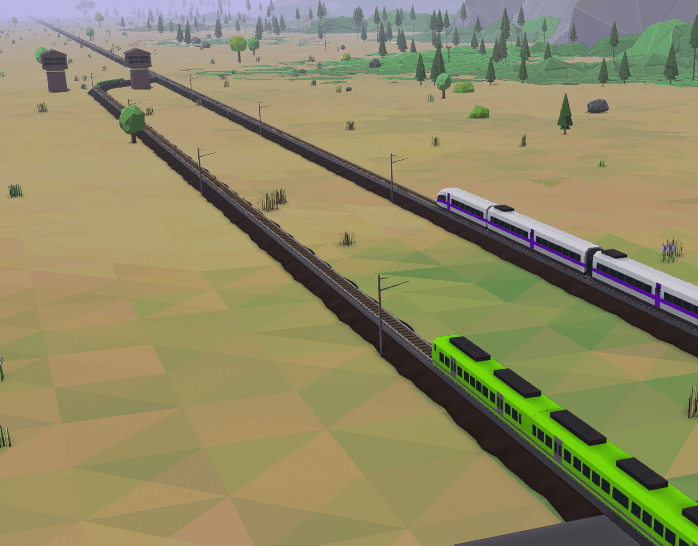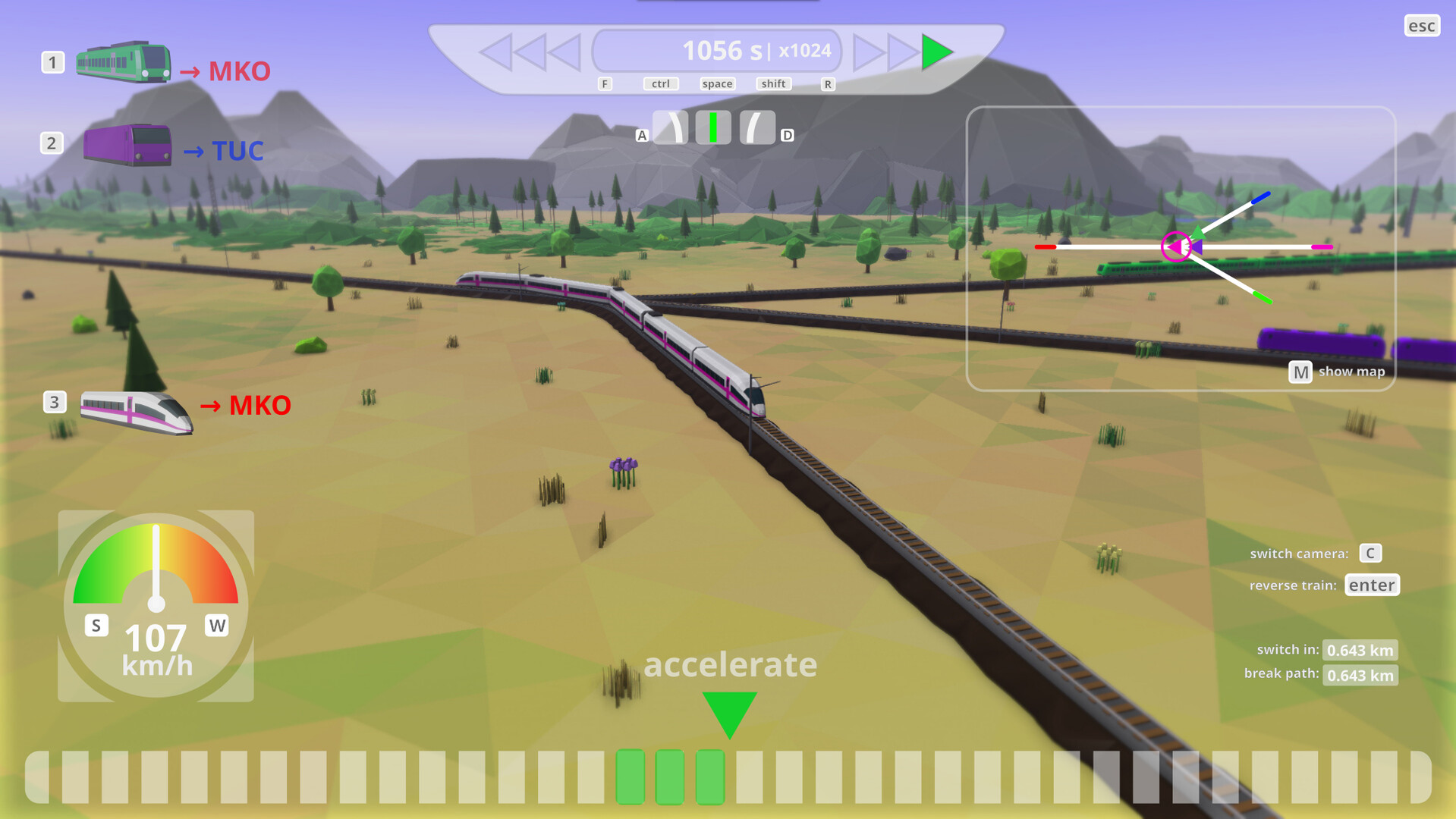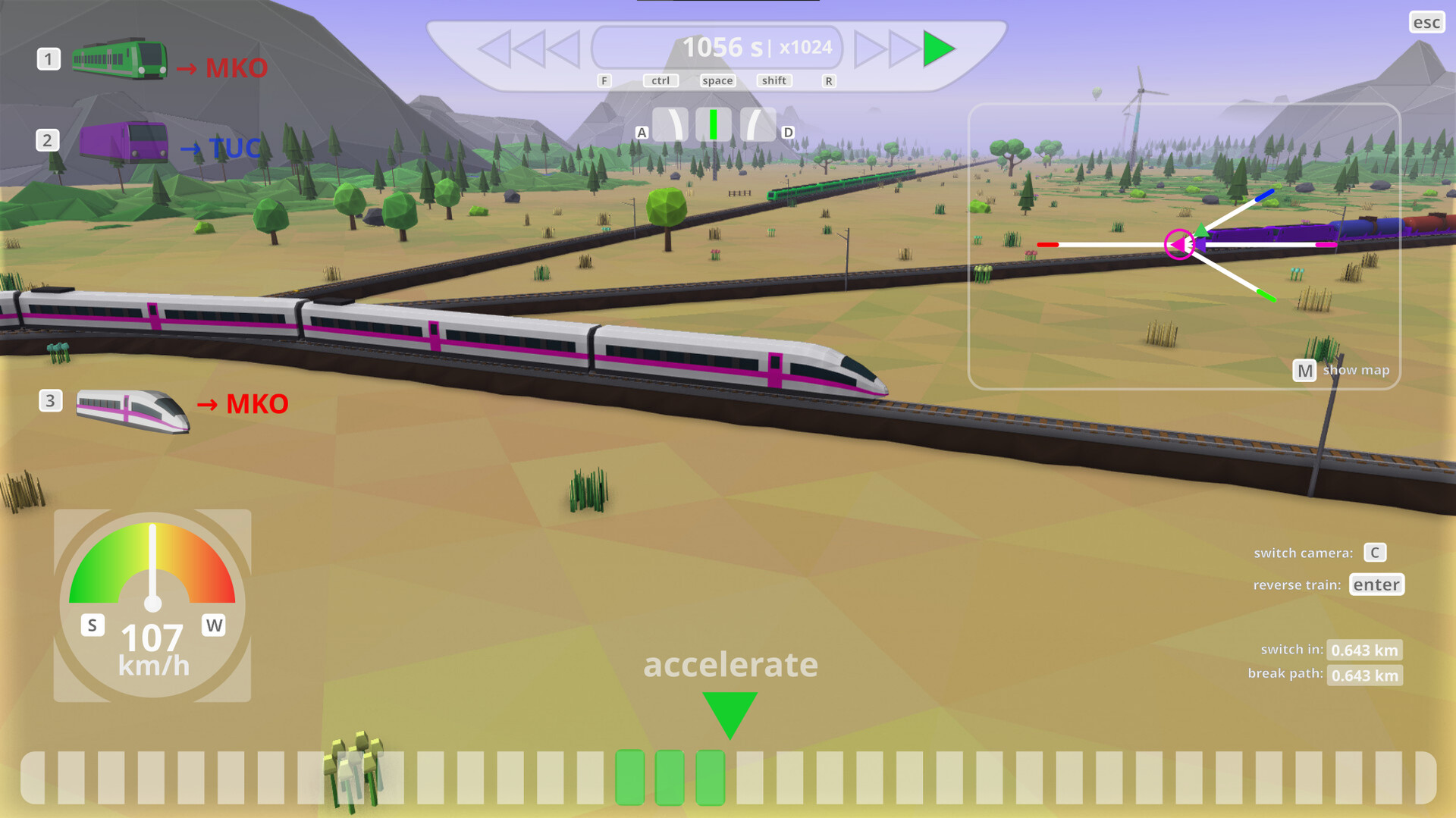
Get ready for an relaxing train adventure in which you'll be tasked with getting trains from point A to point B while avoiding collisions and completing each level in the fastest time possible. With the ability to control time, you'll have the power to determine the game's speed and even go back in time to fix any mistakes and optimize the travel time for every train.

Game Play
Every train needs to be directed towards a designated station that is recognizable by a three-character code (e.g., BXR, HTG), as depicted on the map [M]. The objective is displayed on the right of the train number. After a train has arrived at its destination, a small checkmark (✔) will be shown next to its goal.
Time Control
Control time, make it faster or slower, reverse it or fast forward it.


Game Play
Every train needs to be directed towards a designated station that is recognizable by a three-character code (e.g., BXR, HTG), as depicted on the map [M]. The objective is displayed on the right of the train number. After a train has arrived at its destination, a small checkmark (✔) will be shown next to its goal.
Time Control
Control time, make it faster or slower, reverse it or fast forward it.

April DevPa
Weve been refining how the game introduces you to its mechanics. The early levels are getting a smoother difficulty curve, so you can learn the ropes without feeling thrown in at the deep end. The goal is to teach you while you play.
Step by step, youll get to grips with:






Because were building Railroad Scheduler in the Rust programming language without a traditional game engine, weve been crafting a lot of systems from scratch including the UI. The in-game HUD is made from basic shapes and text, which worked fine until we wanted things like volume sliders or display settings.
To make that happen, we integrated egui, a Rust-based UI library. That allowed us to start building proper settings menus with:


[hr][/hr]
Thanks for checking out the project! If youre into thoughtful scheduling gameplay, trains, or just like seeing a game built from the ground up in Rust wed love to have you on board.
More updates coming soon. Until then: stay on track!
Hi there!
Were a small team working on Railroad Scheduler, and every once in a while, we get together in person for a few days to focus entirely on development. We call these little sprints DevPa (short for Development Party). It's not all confetti and pizza but it's pretty close.
During our latest DevPa a couple of weeks ago, we spent about five days improving two big parts of the game:
Better Early Missions
Weve been refining how the game introduces you to its mechanics. The early levels are getting a smoother difficulty curve, so you can learn the ropes without feeling thrown in at the deep end. The goal is to teach you while you play.
Step by step, youll get to grips with:
- Accelerating, braking, and stopping at the right spots
- Switching tracks (left, right, straight ahead)
- Reversing the train and adjusting the camera
- Fast-forwarding and rewinding time
- Pulling off more advanced maneuvers






More Functional Menus
Because were building Railroad Scheduler in the Rust programming language without a traditional game engine, weve been crafting a lot of systems from scratch including the UI. The in-game HUD is made from basic shapes and text, which worked fine until we wanted things like volume sliders or display settings.
To make that happen, we integrated egui, a Rust-based UI library. That allowed us to start building proper settings menus with:
- Audio sliders
- Display mode selectors
- Scrollable panels


[hr][/hr]
Thanks for checking out the project! If youre into thoughtful scheduling gameplay, trains, or just like seeing a game built from the ground up in Rust wed love to have you on board.
More updates coming soon. Until then: stay on track!
[ 2025-05-12 13:16:07 CET ] [Original Post]
Rail Network Outlines for Decoration
To solve this, were moving toward importance sampling based on the distance to rail tracks. This means:
Dingbats spawn where they should (at the desired distance to the tracks).
We dont have to discard as many placements, making the algorithm more efficient.
The end result? A more diverse and natural-looking distribution of decoration with less computational waste.

Here you can see the outlines generated around the tracks, directly in the environment. These areas guide where dingbats can appear, helping us place decorations naturally and efficiently based on their proximity to the rails.
To make the world of Railroad Scheduler more visually rich, were working on an optimized system for decorative object placement.
Dingbats & Biomes
Decorative elements (dingbats) like trees, rocks, houses etc. are placed around the rail tracks to enhance the visual atmosphere. Depending on the region, the game will feature different biomes, each with its own set of dingbats (e.g. urban vs. countryside).Smarter Dingbat Placement
Previously, we used rejection sampling to scatter dingbats around the rails. While this worked, it didnt scale well especially when placing lots of objects.To solve this, were moving toward importance sampling based on the distance to rail tracks. This means:
Dingbats spawn where they should (at the desired distance to the tracks).
We dont have to discard as many placements, making the algorithm more efficient.
The end result? A more diverse and natural-looking distribution of decoration with less computational waste.

Here you can see the outlines generated around the tracks, directly in the environment. These areas guide where dingbats can appear, helping us place decorations naturally and efficiently based on their proximity to the rails.
[ 2025-04-08 19:37:05 CET ] [Original Post]
Minimum Setup
- Storage: 150 MB available space
GAMEBILLET
[ 6583 ]
GAMERSGATE
[ 4105 ]
MacGamestore
[ 6065 ]
FANATICAL BUNDLES
HUMBLE BUNDLES
by buying games/dlcs from affiliate links you are supporting tuxDB

















